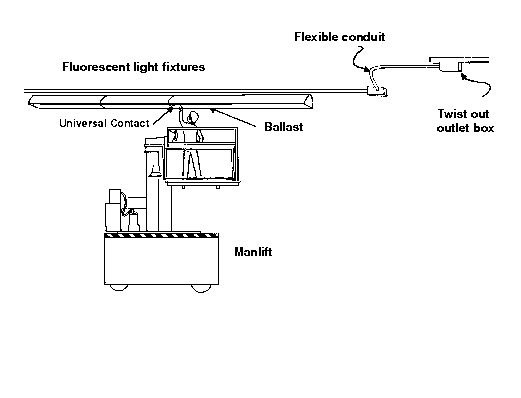34-Year-Old Maintenance Worker Electrocuted in Ohio
FACE 86-35
Introduction
The National Institute for Occupational Safety and Health (NIOSH), Division of Safety Research (DSR) is currently conducting the Fatal Accident Circumstances and Epidemiology (FACE) Project, which is focusing primarily upon selected electrical-related and confined space-related fatalities. The purpose of the FACE program is to identify and rank factors that influence the risk of fatal injuries for selected employees.
On June 29, 1986, a maintenance worker temporarily assigned to the night shift was electrocuted while in the process of replacing a ballast in a fluorescent light fixture.
Contacts/Activities
Officials of the Industrial Commission of Ohio notified DSR concerning this fatality and requested technical assistance. This case has been included in the FACE Project. On July 21-22, 1986, a safety specialist and a safety engineer met with representatives of the employer and interviewed co-workers and next-of-kin.
Overview of Employer’s Safety Program
The employer is a manufacturing company that employs approximately 2000 people. The company operates three shifts five days a week. The company employs a full-time director of safety and security, an assistant director, and a secretary. The safety department staff spends 65 percent of its time on security and environmental issues. The director of safety is in the process of rewriting company safety and security manuals. The frequency and severity rates of the employer are comparable to those rates within the manufacturing industry.
Synopsis of Events
The 34-year-old victim had been employed as a maintenance worker for 16 years with this employer. He had been assigned to work vacation relief on the third shift. At the time of the incident he was starting the last week of this three week assignment.
As the victim entered the factory at approximately 11:00 p.m. he noticed an overhead fluorescent light was out. Since he was the only maintenance worker on the third shift, it was his responsibility to replace the ballast and fluorescent tubes. This was considered a routine task for the victim. After returning from the maintenance shop with new tubes and a ballast, he obtained a manlift to elevate himself 12 feet above the floor to a height where he could comfortably work on the light fixture. (See figure.) He removed the old tubes, metal shade, and a line fuse from the black wire which he assumed was the hot wire. The victim did not de-energize the conductor to the fluorescent lights. This could have been easily accomplished by disconnecting the twist out outlet box attached to the universal lighting duct or by removing the universal contact which was located beneath the metal fixture and which helps support the light fixture. He then cut all eight wires which were connected to the old ballast and started to strip insulation from the white wire. Apparently while holding the white wire in his left hand, he braced his left index finger against the metal structure supporting the light fixture. Holding the wire strippers in his right hand, the victim began to strip the insulation from the conductor. As he was stripping the insulation his metal wire stripper made contact with the hot conductor at the same time his left hand was braced against the metal structure. The victim received an electrical shock from the 277 volts which serviced the light fixture.
A co-worker heard a noise, turned from her work station, and saw the victim laying face up on the platform of the manlift. She immediately summoned a nearby worker who lowered the platform and moved the victim onto the floor. Workers immediately began CPR and continued until the EMS arrived. The EMS attempted to revive the victim at the site for 30 minutes before transporting him to a local hospital. He was pronounced dead two hours later.
Cause of Death
The coroner ruled that electrocution was the cause of death.
Recommendations/Discussion
Recommendation #1: Employees who work with electrical conductors should de-energize the conductors and take appropriate action to ensure the conductors can not be accidently re-energized.
Discussion: Within 20 feet of the accident site a twist out outlet box was attached to a universal lighting duct. The purpose of the twist out outlet box and the universal lighting duct is to provide 277 volt service to four fluorescent light fixtures in the area. All conductors in the light fixtures would have been de-energized by disconnecting the twist out outlet box. As an added safety precaution, the line fuse located inside the light fixture should be removed as well. In this case the line fuse was removed. Unfortunately the fuse was on the black (neutral) wire and not the white (hot) wire. The victim could have de-energized the light fixture he was working on by disconnecting the universal contact; however, this is more difficult because the universal contact supports the lighting fixture. The universal contact works exactly like the twist out outlet box. Both the twist out outlet box and the universal contact involved in this incident were non-polarized units. One of these units was installed backwards causing reverse polarity in the conductors. By not maintaining polarity, the black wire in the lighting fixture became the neutral and the white wire became hot.
Recommendation #2: Correct electrical polarity should be maintained throughout the electrical service area.
Discussion: The busway within the universal lighting duct is marked + and -. The twist out outlet box should be installed within the universal lighting duct so that polarity is maintained. The twist out outlet box and the universal contact involved in this incident were not polarized. One of these two units was installed backwards which caused reverse polarity. The twist out outlet box involved in this accident had been installed in 1965. Newer outlet boxes are polarized and will maintain polarity in the universal lighting duct. All electrical systems at the manufacturing plant should be evaluated to assure correct polarity is maintained.

Figure. Worker Replacing Ballast from Manlift Platform
